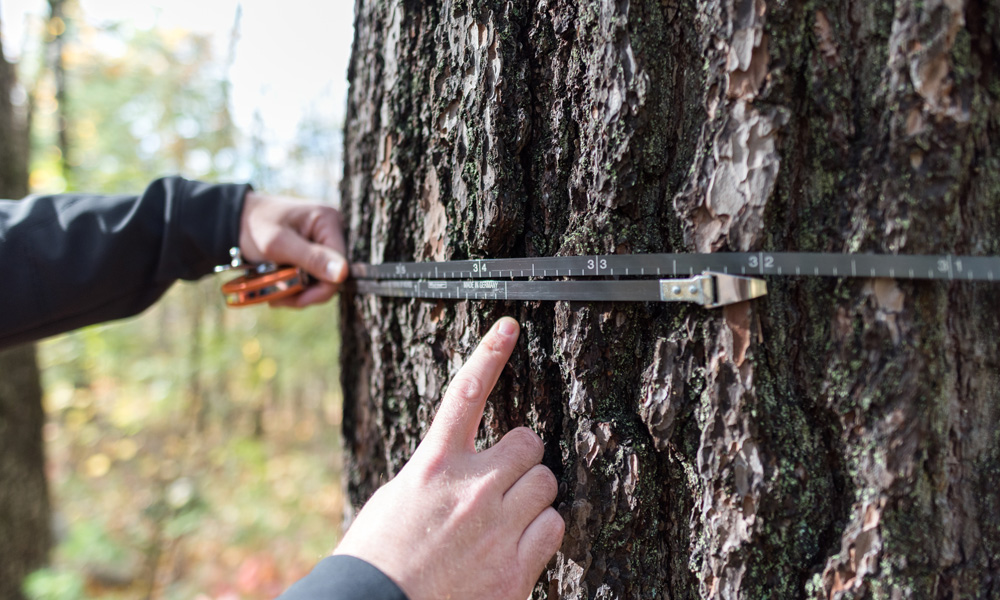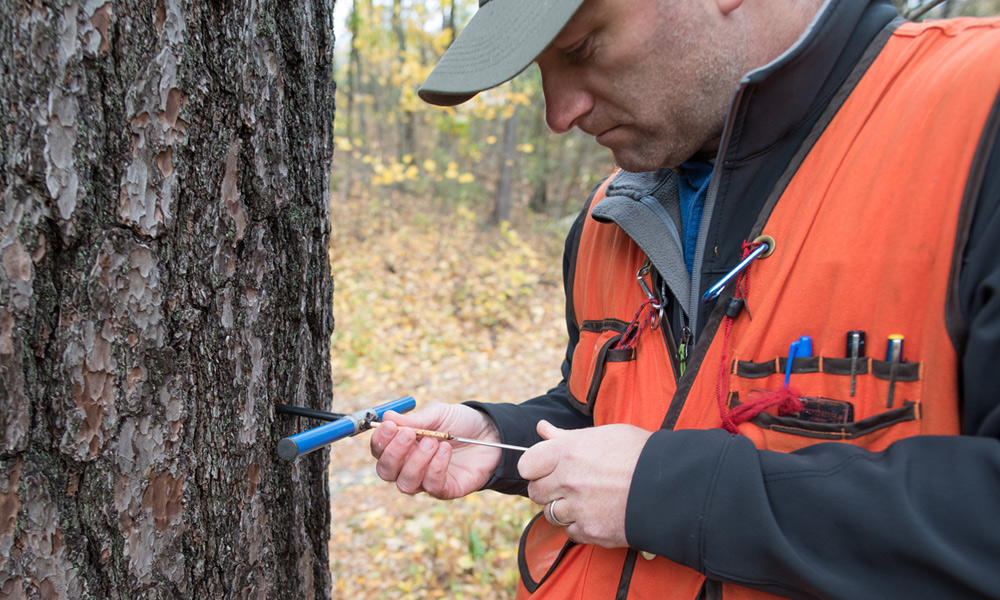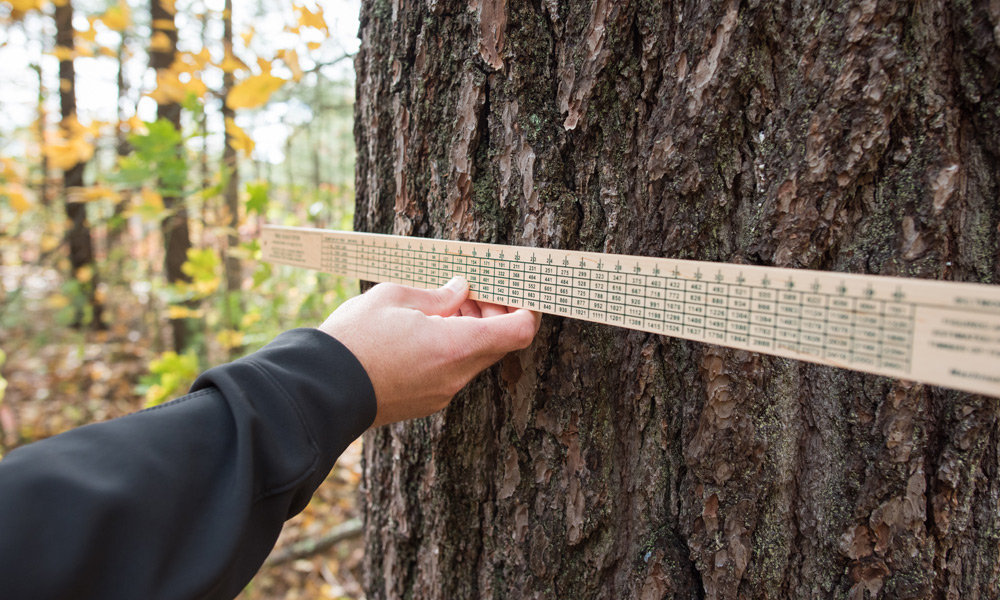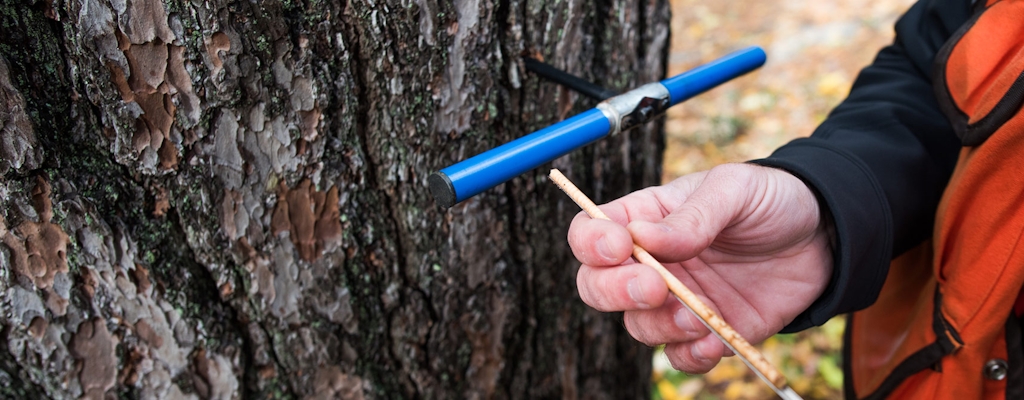Smudges of blue paint, an orange vest, and a clipboard—the forester’s uniform is a familiar sight for many New Englanders. But how many are well versed in the gadgets that help foresters do their job? From the increment borer to the clinometer, each instrument has been specifically crafted to learn more about every forester’s greatest obsession: trees.
Here are a few of the tools you might find in a forester’s vest, and how foresters use them in the field:

Diameter Measuring Tape (D-Tape)
To avoid time-consuming calculations in the field, D-Tape is designed to directly measure the diameter of a cylindrical object—in the forester’s case, trees. With standard measurements of length on one side of the tape and diameter conversions on the other, D-Tape serves as the forester’s cheat-sheet for obtaining a fairly accurate estimate of the tree’s diameter. Combined with the tree’s height, foresters can estimate the volume of wood in a given tree.
Clinometer
Short of chopping a tree down or climbing to the top with tape measure in hand, foresters must rely on indirect methods of measurement to approximate a tree’s height. A clinometer, or device that measures angles, allows foresters to do just that. Clinometers vary in their design and sophistication—some are glorified compasses and simply measure angles that can be used to calculate tree height through applied trigonometry, while others instantaneously produce an estimate of tree height with advanced laser technology. Clinometers can also be used to measure the slope of a hillside, which can be useful when planning skid trails or management strategies. Backcountry skiers also rely on clinometers to help them estimate avalanche danger.
Densiometer
How enclosed or open a tree canopy is will influence what tree or plant species will flourish on the forest floor, and how quickly it will grow. The less dense a canopy, the more light will hit the forest floor and encourage growth. Foresters use densiometers to estimate tree canopy percent cover. Simple in design, a densitometer is a convex or concave mirror that is divided into a grid. By holding the pocket-sized densiometer at arm’s length, a forester can count the number of boxes in the grid that contain canopy, and then divide this number by the total number of boxes. This procedure is repeated multiple times in a given area, and the percentages are averaged together for an approximation of the canopy cover.

Increment Borer
Tree rings hold valuable information about the age of a tree and growth rates over time. An entire scientific field of study, dendrochronology, is dedicated to dating and analyzing tree rings. Until the late 1800s, tree rings could only be studied after harvesting a tree and preparing a cross section of its trunk. With the invention of the increment borer, foresters and scientists were given the ability to extract core samples from living trees, with little harm to the tree.
How does it work? The borer is made up of a hollow drill bit, typically 1/5” in diameter. The bit is connected to a long, hollow, metal shaft, which connects to a steel t-bar handle. Rotating the handle clockwise turns the bit and drives the borer into the tree. Once the borer reaches just past half of the tree’s diameter, a “spoon” is inserted into the hollow shaft to help cut and remove the cylindrical core. After the core is removed, the bit is promptly reversed out of the tree to avoid binding.
Foresters study tree cores to age trees accurately, and to better understand how quickly trees are growing. This information can help the forester understand a site’s growing conditions, which helps inform a more precise management plan for the forest.

Biltmore Stick
While it might not fit in a forester’s vest, the Biltmore stick continues to be a valuable tool in the forester’s arsenal. This instrument allows a forester to produce a rough estimate of the board feet of lumber that a tree might produce. A forester simply holds the stick against a tree trunk at arm’s length, and takes a reading from the calibrated numbers. While the Biltmore stick has its limitations, it provides a useful reference for what a forester can expect from a tree’s harvest.
While this list of gadgets is by no means comprehensive (and some of these tools are used less frequently today than in the past), it does offer a window into the types of information foresters collect when surveying a forest. Using this information, foresters are able to write a management plan, prescribe harvests, and monitor forests over time to ensure the forest remains healthy and productive.
Writing and photography by Charlie Reinertsen.


